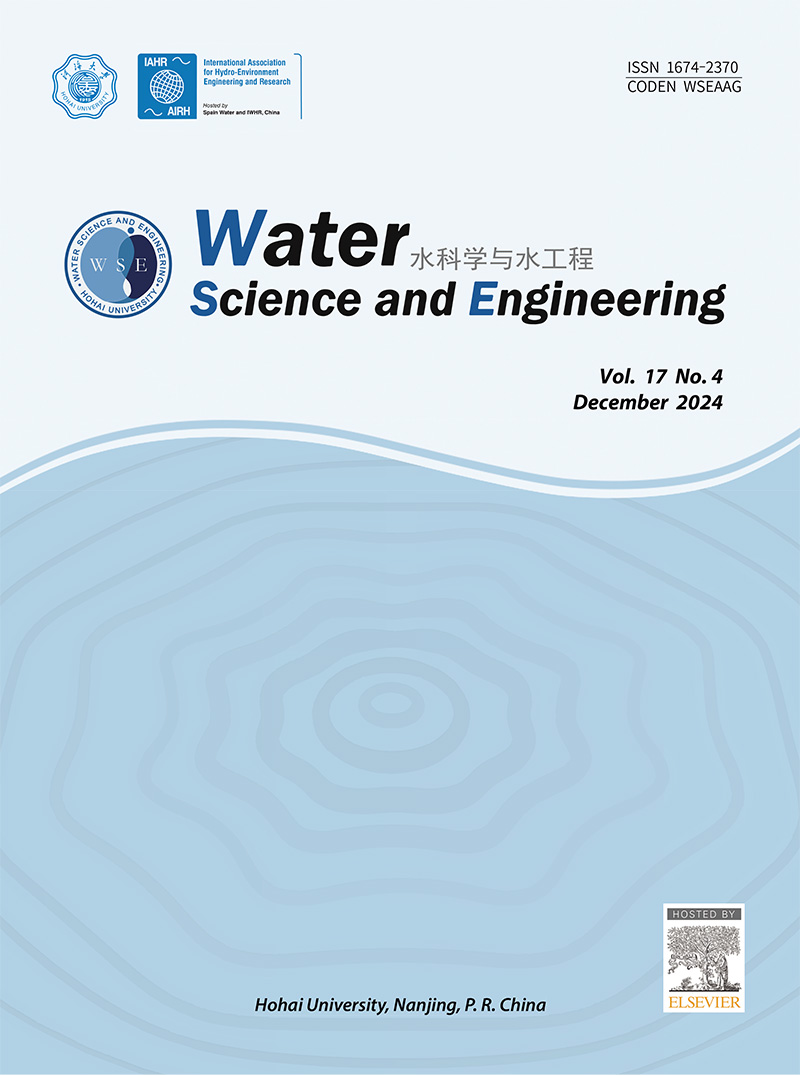Sedimentary bed morphology in the wake of flexible aquatic vegetation
IF 4.3
Q1 WATER RESOURCES
引用次数: 0
Abstract
The sedimentary bed morphology modulated by the wake flow of a wall-mounted flexible aquatic vegetation blade across various structural aspect ratios (AR = l/b, where l and b are the length and width of the blade, respectively) and incoming flow velocities was experimentally investigated in a water channel. A surface scanner was implemented to quantify bed topography, and a tomographic particle image velocimetry system was used to characterize the three-dimensional wake flows. The results showed that due to the deflection of incoming flow, the velocity magnitude increased at the lateral sides of the blade, thereby producing distinctive symmetric scour holes in these regions. The normalized morphology profiles of the sedimentary bed, which were extracted along the streamwise direction at the location of the maximum erosion depth, exhibited a self-similar pattern that closely followed a sinusoidal wave profile. The level of velocity magnitude enhancement was highly correlated to the postures of the flexible blade. At a given flow velocity, the blade with lower aspect ratios exhibited less significant deformation, causing more significant near-bed velocity enhancement in the wake deflection zone and therefore leading to higher erosion volumes. Further investigation indicated that when the blade underwent slight deformation, the larger velocity enhancement close to the bed can be attributed to more significant flow deflection effects at the lateral sides of the blade and stronger flow mixing with high momentum flows away from the bed. Supported with measurements, a basic formula was established to quantify the shear stress acting on the sedimentary bed as a function of incoming flow velocity and blade aspect ratio.
柔性水生植被尾迹中的沉积层形态
实验研究了壁挂柔性水生植被叶片尾流在不同结构长径比(AR = l/b,其中l和b分别为叶片的长度和宽度)和来流速度下对沉积床形态的调节。采用表面扫描仪对河床形貌进行量化,采用层析粒子成像测速系统对三维尾流进行表征。结果表明,由于来流的偏转,叶片侧面的速度幅度增大,从而在这些区域产生明显的对称冲刷孔。在最大侵蚀深度处沿顺流方向提取的归一化沉积层形态剖面显示出与正弦波剖面密切相关的自相似模式。速度幅度的增强程度与柔性叶片的姿态高度相关。在一定流速下,低展弦比的叶片变形不明显,尾迹偏转区近床速度增强更明显,从而导致更高的侵蚀体积。进一步研究表明,当叶片发生轻微变形时,靠近床层的速度增强较大,这可能是由于叶片侧面的流动偏转作用更为显著,并且与远离床层的高动量流动混合更强。在测量的支持下,建立了一个基本公式,将作用在沉积层上的剪切应力量化为来流速度和叶片展弦比的函数。
本文章由计算机程序翻译,如有差异,请以英文原文为准。
求助全文
约1分钟内获得全文
求助全文
来源期刊

Water science and engineering
WATER RESOURCES-
CiteScore
6.60
自引率
5.00%
发文量
573
审稿时长
50 weeks
期刊介绍:
Water Science and Engineering journal is an international, peer-reviewed research publication covering new concepts, theories, methods, and techniques related to water issues. The journal aims to publish research that helps advance the theoretical and practical understanding of water resources, aquatic environment, aquatic ecology, and water engineering, with emphases placed on the innovation and applicability of science and technology in large-scale hydropower project construction, large river and lake regulation, inter-basin water transfer, hydroelectric energy development, ecological restoration, the development of new materials, and sustainable utilization of water resources.
 求助内容:
求助内容: 应助结果提醒方式:
应助结果提醒方式:


